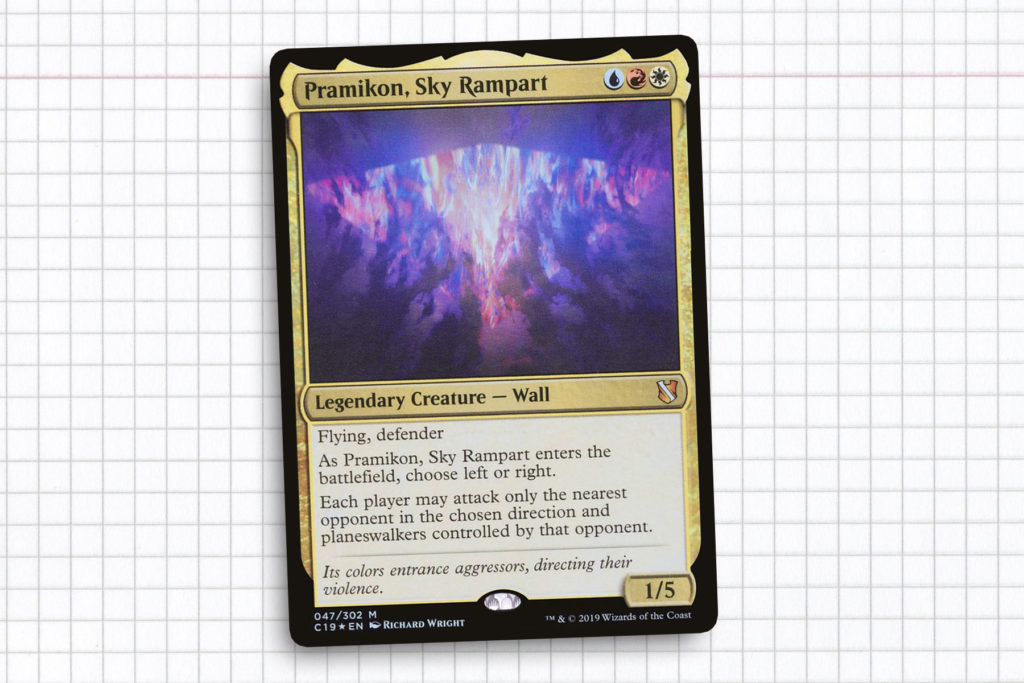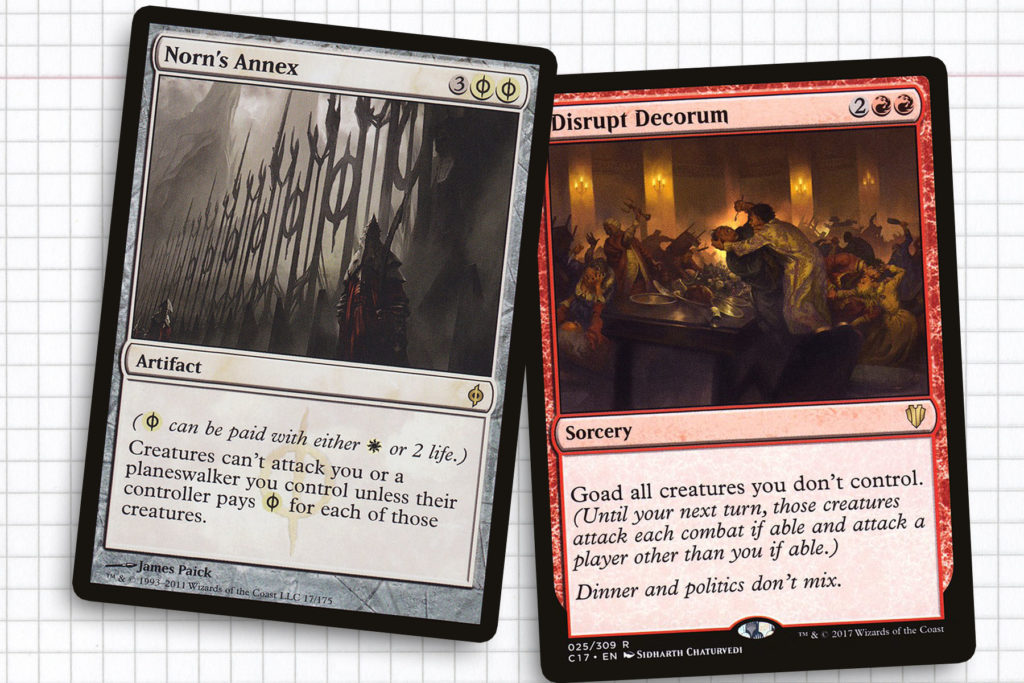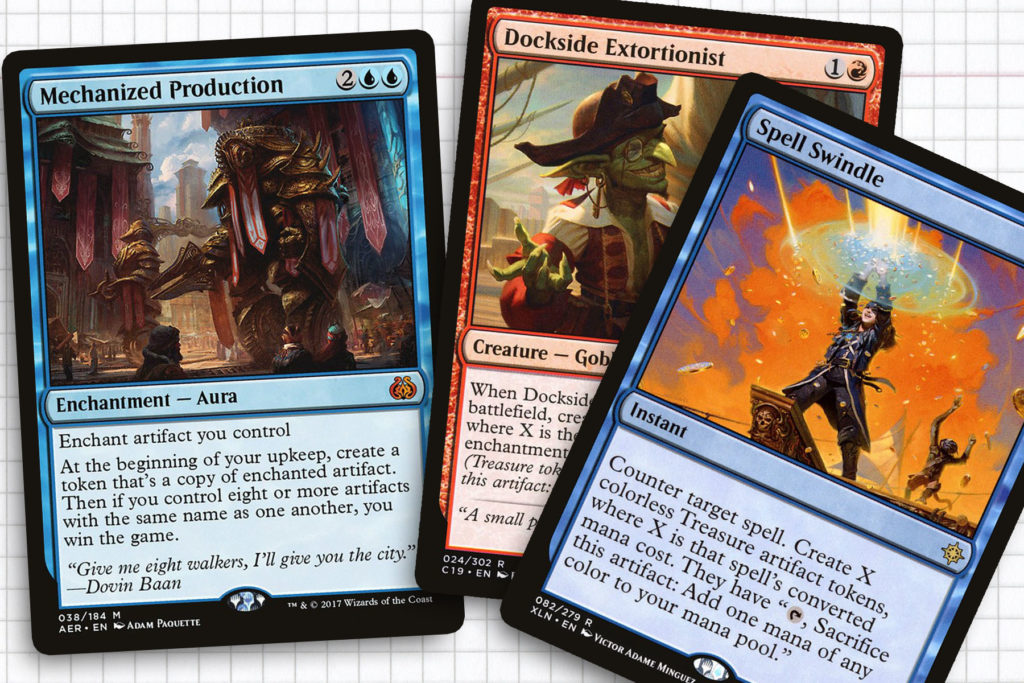The last few weeks have bled together for me. The shelter-in-place environment, isolated from the outside world, has been a nice escape from the pressures of traffic, productivity logs, and haircuts. But at the same time, it’s been a very real weight on my mental stability as I lose a grip on relationships I took for granted, the brief accomplishment that came from just getting to work on time, and the act of doing anything. I feel I’ve done nothing of merit in the past few weeks.
In the spirit of both isolation with limited interaction and the drive to be in control of our own destiny, I thought it would be fitting to analyze a deck that does all of that in the most political and effective manner I could conceive. This week, we’ll be looking at Pramikon, Sky Rampart. We’re looking to offer the rest of the table the illusion of choice, while giving ourselves more than a handful of ways to choose to win. This deck fights my instincts a little and plays for the long game over easily measurable progress. But in these times of crisis, change is very welcome.
Here’s the deck:
Commander: Pramikon, Sky Rampart
Creatures: Archon of Absolution, Auriok Champion, Baird, Steward of Argive, Burnished Hart, Dockside Extortionist, Faerie Artisans, Fumiko the Lowblood, Humble Defector, Hunted Dragon, Hunted Lammasu, Hunted Phantasm, Isperia, Supreme Judge, Kazuul, Tyrant of the Cliffs, Soul Warden, Soul’s Attendant, Wall of Denial, Windborn Muse
Planeswalker: Kasmina, Enigmatic Mentor, Saheeli, Sublime Artificer
Artifacts: Aetherflux Reservoir, Azorius Signet, Boros Signet, Caltrops, Darksteel Ingot, Fellwar Stone, Izzet Signet, Norn’s Annex, Shrine of Loyal Legions, Temple Bell, Thought Vessel, Thran Dynamo
Instant: Arcane Denial, Cyclonic Rift, Ephemerate, Ethereal Haze, Holy Day, Narset’s Reversal, Negate, Spell Swindle, Teferi’s Time Twist
Sorcery: Brass’s Bounty, Disrupt Decorum, Divine Reckoning, Rite of Replication, Time Wipe
Enchantment: Ajani’s Welcome, Ashling’s Prerogative, Breath of Fury, Compulsion, Curse of Verbosity, Deafening Silence, Dictate of the Twin Gods, Dissipation Field, Furnace of Rath, Ghostly Prison, Goblin Bombardment, Martyr’s Cause, Mechanized Production, Propaganda, Smothering Tithe, Sphere of Safety, Vicious Shadows
Land: 5 Island, 4 Mountain, 6 Plains, Ash Barrens, Clifftop Retreat, Command Tower, Forgotten Cave, Glacial Fortress, Hallowed Fountain, Lonely Sandbar, Maze of Ith, Mystic Monastery, Mystifying Maze, Reliquary Tower, Rogue’s Passage, Sacred Foundry, Secluded Steppe, Steam Vents, Sulfur Falls, Swiftwater Cliffs, Temple of Enlightenment, Temple of Epiphany, Temple of Triumph, Tranquil Cove, Wind-Scarred Crag

The Wall Approaches
Pramikon, Sky Rampart, as Magic’s first legendary wall, had a lot to live up to as a fan-requested addition to the game. After some thought and analysis, I believe it was a success. The first inclination when I envisioned a legendary wall was something that would work similarly to Doran, the Siege Tower—explicitly make walls more important and possibly allow for the niche wall tribal deck.
But on second thought, making creatures with high toughness more valuable, possibly with Rolling Stones stapled on is ultimately Arcades, the Strategist. That steps on the toes of other colors design space and wouldn’t have played well enough into the political nature of the Jeskai color identity. Seeing as we had yet to see a general playing in this space; walls as inanimate objects have no agency meant that controlling the direction of attacks could be an efficient design space to help sell why this was a wall instead of something else.
As my mind started turning, choice became a running theme for me. I wanted to sow in choice by making something like attacking as fruitful as possible with Dictate of the Twin Gods and Furnace of Rath doubling or quadrupling damage. But choice was going to be a bit of an illusion as well. If you didn’t have attackers, I could supply them with Hunted Dragon, Hunted Lammasu, and Hunted Phantasm. If you didn’t want to attack, Fumiko the Lowblood would have none of that. But after some thinking, I chose not to include Bedlam, because it removed the choice of blocking from me.

Controlling Choice
By design our general wants to limit the options of the table, restricting the flow of attack and giving players only one option for attacking. In a vacuum, I would personally send everyone in the opposite direction that the table rotates, pushing the line of thinking where the active player is always the target next turn. This leaves decks that are solely aggressive to either make a move or waste their turn because they’re fearful of what might happen to them if they act. This cold war state is really what my deck is going to feed off of in order to buy the time to win the game.
For my own protection, I’m packing deterrents like Ghostly Prison, Kazuul, Tyrant of the Cliffs, and Norn’s Annex. Those will leave my designated attacker with the choice of either playing spells or attacking me—like a discreet Angelic Arbiter. This continual defense allowed for me to trim down the size of reactive spells like Safe Passage or Warning that only prevent damage once a game.
We also don’t want to overlook the power spells like Ephemerate and Teferi’s Time Twist can have to change the direction of attack, removing an option for the opponent that has been scheming to alpha strike us and making them our target instead. When our general is not in play, spells like Disrupt Decorum and Dissipation Field will mean that even if we can’t point our opponents exactly where we want, we’ll make them weigh a lot of options that aren’t us.

Options for Victory
As is, Pramikon lends itself towards a game that could last for hours and come down to a prolonged game of attrition. That’s not really the angle I want to take. I don’t happen to find decks that pressure players to simply concede to be at all interesting or fun, instead looking to build to a definitive ending for the game. With our deck already bringing restrictions of options, it’s safe to say that we can reasonably rely on alternate win conditions as a method of finishing the game.
The first avenue to victory to consider is Mechanized Production, which can be achieved over many turns—or by using Dockside Extortionist, Spell Swindle, or Brass’s Bounty to accelerate the process. While winning the game this way may honestly be a bit of a pipe dream, we can leverage Mechanized Production to do things like create more copies of Caltrops, Shrine of Loyal Legions, or Norn’s Annex, giving us a disproptional advantage. This is an important factor to keep in mind, if the game requires it; don’t think of Mechanized Production only as a win condition.
Moving beyond a strategy that explicitly tells you how to the game, we have Vicious Shadows, which seasoned players will know sometimes wins before the table ever realizes it. We’d like to have more dedicated control over when and how creatures are dying, but Time Wipe, Disrupt Decorum, and Divine Reckoning help ensure that creature will be dying at a reasonable pace.
Importantly, we don’t even need to focus on specific creatures to haul damage at specific players, as the trigger allows us to direct the damage to anyone. This allows Deafening Silence, Cyclonic Rift, and Dissipation Field to have strategic purpose, as they will grow the hand sizes of the table as a byproduct of being played. And then there is Breath of Fury, which wins games on its own, and gives us a chance to sacrifice creatures and lower the life totals of players we might not be alpha striking at present.
Finally, we have a complete overkill route to victory that feeds off the political nature of the deck. While not a great combo with every card in the deck like Deafening Silence, we can always use all the stalling to win with Aetherflux Reservoir in combination with Soul Warden, Soul’s Attendant, and Auriok Champion. This set of clerics will easily combo with a developed Shrine of Loyal Legions to keep us out of strike distance of an alpha strike and possibly even a political victory.
The foundation of this deck is not built upon my favorite kind of strategy. Regardless, I think it’s always a good idea to consider decks you’ve ignored in the past and find a way to express yourself under these changed circumstances. There is a very good chance that I could find myself revisiting this deck in a year, having found new angles to make the deck more efficient and individual to my playstyle. I’m attracted to this deck because deep down, I enjoy putting players into decision paralysis from time to time—especially if the decision was never there’s to make in the first place. Stay safe everyone, I’ll see you next time.
Ryan Sainio is a Graphic Designer who writes about EDH and the EDH community. He has been playing Magic: The Gathering since 7th Edition in 2002 and values flavorful and fun gameplay over competitively optimized decks.

